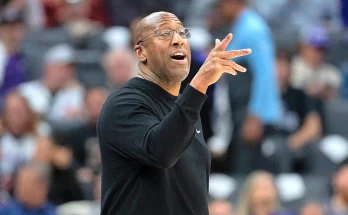When LSU made the move to bring in a talented transfer cornerback during the offseason, there was cautious optimism in Baton Rouge. Transfers often come with a mixture of excitement and uncertainty—some adapt seamlessly, while others take longer to find their footing in a new system. But in this case, the transition has been nothing short of remarkable. The Tigers’ new defensive back has not only fit in but has emerged as one of the most influential figures on the roster, setting a tone of confidence, grit, and game-changing ability that could define the team’s 2025 campaign.
From the moment he arrived on campus, his presence was felt. The coaching staff immediately noticed a competitor who was both eager to learn and determined to lead. He brought with him a mix of physical tools—elite speed, fluid hip movement, and sharp instincts—that made him a natural fit for LSU’s aggressive defensive philosophy. But perhaps more importantly, he arrived with an edge, a mentality that signaled he wasn’t just here to blend in; he was here to change the way opponents attacked LSU’s secondary. That determination has quickly transformed him from a hopeful addition to a central piece of the Tigers’ championship blueprint.
The first weeks of spring practice were telling. Wide receivers who had dominated matchups in past seasons suddenly found themselves working harder for every inch of separation. Routes that typically developed smoothly were being disrupted by perfectly timed jams at the line of scrimmage. Quarterbacks accustomed to quick, decisive reads were hesitating for just a split second longer—a dangerous delay when facing LSU’s pass rush. It wasn’t just about his physical ability; it was about the ripple effect of his confidence. His presence seemed to raise the competitive standard in the defensive back room, and even veteran corners admitted privately that his hunger was contagious.
One of the most striking aspects of his emergence has been his versatility. While he was primarily recruited as an outside corner, LSU’s defensive coaches have found creative ways to use him all over the field. In certain packages, he slides inside to match up against shifty slot receivers, using his quickness to stay glued to their hips. In others, he takes on the challenge of shadowing an opponent’s top target for the entirety of a game, effectively erasing them from the stat sheet. His adaptability not only gives defensive coordinator flexibility but also forces opposing offenses to adjust on the fly—often to their detriment.
The ripple effect extends beyond the field. In team meetings, he has emerged as a vocal presence, challenging younger players to sharpen their preparation habits and holding everyone to a standard of accountability. When mistakes happen in practice, he is often the first to address them—not in a confrontational way, but in a manner that makes it clear the Tigers’ goals require total commitment. It’s rare for a transfer to step into a leadership role so quickly, but his teammates have embraced him fully because they see the work ethic and results to match the words.
Game footage from LSU’s early-season matchups has already shown why his addition could be a season-defining move. Against a high-powered nonconference opponent in the opener, he was tested early and often, as the opposing quarterback targeted him on deep routes to see if he could be beaten over the top. Each time, he responded with textbook positioning, forcing incompletions and frustrating the opposing sideline. By the third quarter, that quarterback had shifted his attention elsewhere—proof of a cornerback doing his job at the highest level. In another contest, his ability to read a developing route allowed him to jump in front of a slant pass and snag a momentum-shifting interception, one that swung the game firmly in LSU’s favor.
What makes his rise even more impressive is the context of LSU’s defensive struggles in recent seasons. The Tigers have been known for producing elite defensive backs—an LSU tradition often referred to as “DBU”—but the past few years have seen inconsistency in coverage, especially against top-tier passing offenses. The arrival of a player who can lock down one side of the field changes everything. It allows safeties to be more aggressive in run support, lets the pass rush focus on collapsing the pocket without worrying as much about blown coverages, and restores a swagger to the secondary that had been missing.
It’s also a testament to LSU’s recruiting and scouting strategy in the transfer portal. The Tigers identified not just a player with the physical tools to compete in the SEC, but one with the mentality and adaptability to thrive in a program with championship expectations. In the portal era, the difference between a solid transfer and a transformational one can be the fine line between being good and being elite. In this case, LSU seems to have found the latter.
Fans have quickly rallied behind him as well. Social media highlights of his plays in practice and early games have gone viral among the LSU faithful, sparking conversations about where he ranks among the nation’s top cornerbacks. Analysts have begun to note that if his trajectory continues, he could be a candidate for postseason honors, from All-SEC selections to All-American consideration. Some have even floated the idea that his draft stock is skyrocketing faster than anyone anticipated, given his combination of measurable traits and on-field production.
His success also reflects the culture head coach Brian Kelly is fostering in Baton Rouge. Kelly has been clear since his arrival that LSU would build on its tradition of producing NFL-ready talent by combining elite athleticism with disciplined execution. The cornerback’s emergence is the embodiment of that vision—proof that the Tigers can not only recruit and develop five-star high school prospects but also identify and maximize the impact of key transfers.
Looking ahead, the road only gets tougher. The SEC schedule is loaded with explosive offenses and NFL-caliber quarterbacks who will test LSU’s secondary at every turn. Matchups against perennial rivals and playoff contenders will put him in the national spotlight, and how he responds could play a major role in determining LSU’s postseason fate. But those close to the program believe he is ready—not just because of his skill, but because of his preparation and relentless drive to improve.
In film sessions, he has developed a reputation for attention to detail. He doesn’t just study his own matchups; he looks at how opposing offenses adjust their game plan over four quarters, noting tendencies that can be exploited late in games. He’s been known to send late-night texts to coaches with questions about specific plays or route concepts, a level of engagement that shows just how invested he is in mastering his craft.
The beauty of his emergence is that it’s not just about statistics. Sure, the interceptions, pass breakups, and low completion percentages allowed will draw headlines, but the real value comes from the confidence he brings to the entire defense. When a cornerback can take away an offense’s best option, it allows the rest of the unit to play faster, looser, and more aggressively. It’s the kind of impact that doesn’t always show up in a box score but is felt deeply in the flow of a game.
By midseason, opposing coordinators will likely have to make a difficult choice: keep testing him and risk turnovers, or avoid his side of the field entirely and play into LSU’s hands. Either way, it’s a win for the Tigers. The more his reputation grows, the more LSU can dictate the terms of engagement in the passing game—a luxury that championship-caliber teams enjoy.
The story of LSU’s 2025 season will be written by many hands—quarterbacks making clutch throws, running backs breaking tackles, defensive linemen collapsing pockets. But there’s a strong argument that one of the most pivotal chapters will revolve around the transfer cornerback who arrived with high hopes and is now delivering in ways that even the most optimistic projections couldn’t have fully imagined. His rise is not just a feel-good subplot; it’s a cornerstone of the Tigers’ identity.
If the Tigers go on to make a run at the College Football Playoff, his fingerprints will be all over their success. The transfer cornerback who started as the “new guy” is now the tone-setter, the one who erases mistakes before they happen, and the player whose confidence has become a guiding force for a defense aiming to reclaim LSU’s place among the nation’s elite. Baton Rouge may be filled with stars on both sides of the ball, but right now, few shine brighter—or mean more to the Tigers’ championship push—than him.


